
By Philip Soos and Paul D. Egan
A perennial and divisive issue in politics and economics today is the matter of public debt. It is commonly asserted that rising public debt threatens the economy and needs to be reined in. Governments are often portrayed as ‘irrational’ actors when they incur a fiscal deficit, causing unnecessary inflation and interest rates to rise by borrowing to meet the shortfall.
Private sector lending is supposedly ‘crowded out’ by lifting the cost of money and limiting access to a finite lending pool by government actors. A large stock of public debt and chronic deficits are considered economically harmful, due to increasing the interest payment burden on taxpayers. A centrepiece of the Abbott government’s economic policy platform is its strident warnings about growing public debt: Australia’s ‘budget emergency’.
This specious claim remains unchallenged, for commentators are generally unfamiliar with the long-term trends in debt and its composition. This analysis fills that void by examining the long-term trends in public, private and external debt. Unsurprisingly, the conclusions arrived at are diametrically opposed and differ sharply to those stemming from the established political and economic narrative.
Public Debt
Public debt is composed primarily of outstanding bonds, although there are other liabilities which tend to be comparatively small by value. The most common method of measuring debt is to compare it to the size of the economy: the debt to GDP ratio. Other similar measures include the net debt and net interest payments to GDP ratios, though the simple comparison of gross debt to GDP allows for long-term assessments.
Public debt relative to GDP was much greater pre-WW2, and today it has fallen to a mere fraction of its former size. The federal debt ratio peaked at 104.2 per cent in 1946, funding Australia’s involvement in WW2, while the state and local gross debt ratio peaked at 123.6 per cent in 1932. The rapid increase was caused by both an absolute rise in debt and the collapse in nominal GDP during the Great Depression of the 1930s.
In the post-WW2 era, both forms of public debt fell swiftly due to persistently strong GDP growth and the rise in taxation revenue offsetting the need for debt to fund public expenditure. The federal and state/local debt ratios fell to a low of 5.1 and 7.4 per cent in 2008 and 1987, respectively. In 2014, the ratios are 20.1 and 16.2 per cent respectively, with government corporation debt at only 0.4 per cent as of 2014.
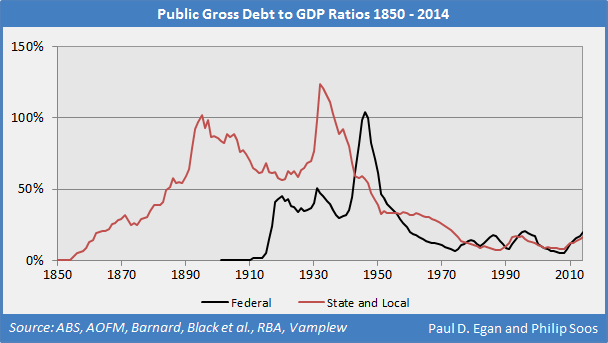
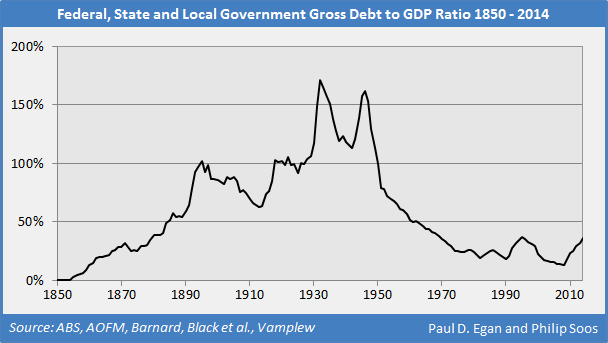
The total federal and state/local debt ratio is 36.4 per cent as of 2014, having peaked at 170.9 per cent in 1932, before falling steadily across several decades to a low of 13.5 per cent in 2008. If the incomplete government corporation debt series is added, total public debt peaked at 239.7 per cent in 1932, falling to a low of 13.7 per cent in 2008.
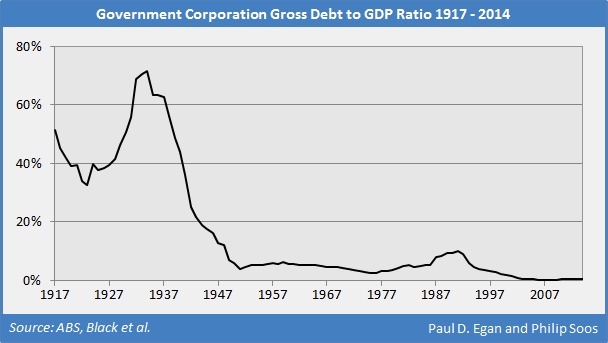
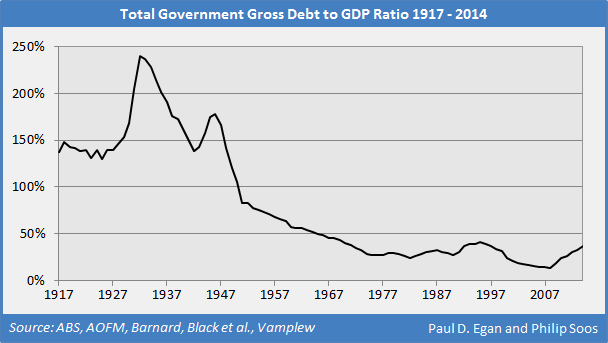
Federal government net debt is lower than gross debt, turning negative between 1972 and 1976, and later on during 2006 to 2009. In 2014, net interest payments were 0.6 and 2.4 per cent of GDP and revenue, respectively; well within the margins of safety. Lower interest rates have translated into lower net interest payments.
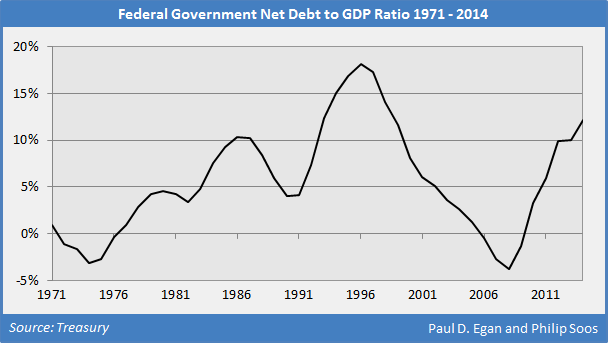
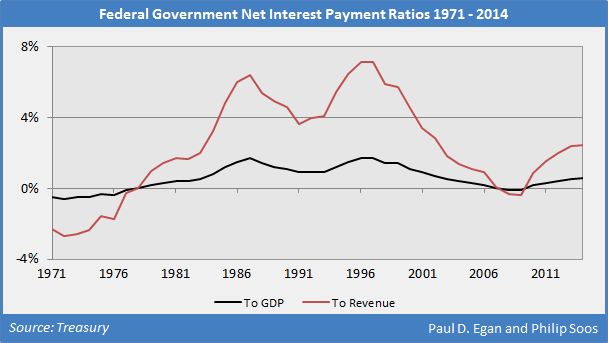
The consolidated balance sheets of all levels of government (federal, state, local and multi-jurisdictional) provide the most accurate overview of public finances. In total, the public sector is comprised of the non-financial public sector and public financial corporations. The non-financial public sector is, in turn, composed of general government (by far the largest component) and public non-financial corporations.
As of 2013, total government assets were worth more than outstanding liabilities, with net worth equivalent to 55 per cent of GDP. Total net debt is only 15 per cent, though the net financial worth ratio was -47 per cent. Overall, the total public sector balance sheet data demonstrates Australian governments are in a strong fiscal position.
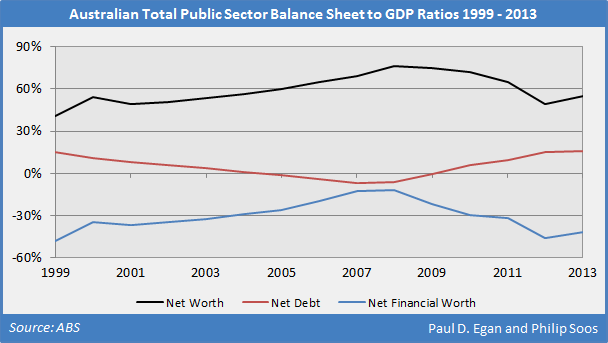
By international standards, Australian federal public debt is relatively small. Even if the public gross and net debt to GDP ratios were to rise moderately, this does not necessarily translate into higher net interest payments if the RBA cuts interest rates and purchases government bonds itself. Given the weakness of the Australian economy outside the FIRE and mining sectors, another cut in interest rates is a distinct possibility.
Private Debt
Private debt is composed of loans issued by lenders to the household, non-financial and non-banking financial sector. It grew exponentially between 1964 and 2008, fuelling the mid-1970s dual commercial and housing real estate bubbles, the early 1980s Sydney housing bubble, the late 1980s dual commercial and housing bubble, and today’s colossal housing bubble and associated commercial property bubble.
The historic peaks in the non-financial business debt ratio match the commercial bubbles of the 1880s, 1920s, mid-1970s, late 1980s and 2008. Non-financial business debt has yet to reach the previous peak of 70.2 per cent set back in 1893. After WW2, accelerating household debt financed housing bubbles during the same periods. The household debt ratio has experienced a remarkable rise over the last two decades, driving the largest housing bubble in Australia’s recorded history.
In the lead-up to the GFC, non-banking financial sector debt rapidly increased, reaching a peak of 116.1 per cent in 2008, before deleveraging. The consolidated private gross debt to GDP figure shown below is a new and novel insight, as it includes for the first time the previously-unexamined non-banking financial sector debt. Unfortunately, this series only begins in 1989.
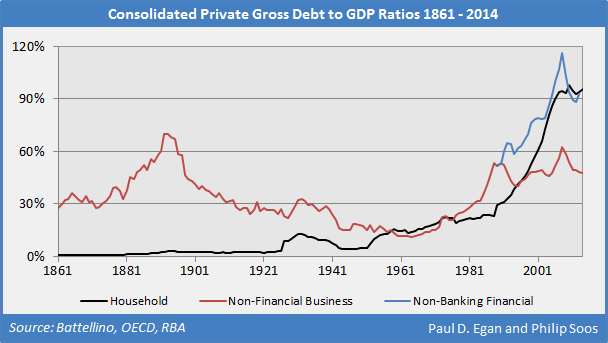
Household debt is overwhelmingly composed of mortgage loans, with a small component of personal debt. The mortgage debt to GDP ratio has risen exponentially from 15.9 per cent in 1988 to a record 86.9 per cent in 2014. Investor debt has surged from 2.8 to 29.3 per cent between 1990 and 2014, demonstrating the speculative mindset of Australians. While personal debt peaked at 13.7 per cent in 2007, more conservative spending habits have resulted in the ratio falling to 9.0 per cent in 2014.
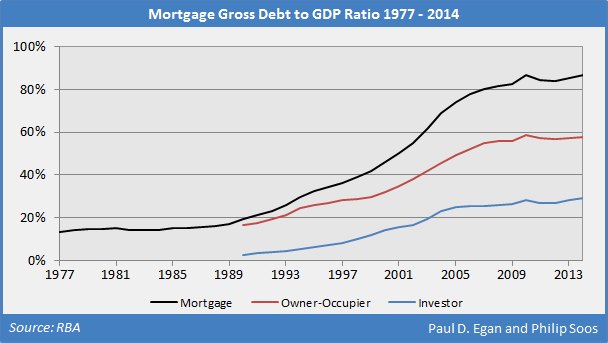
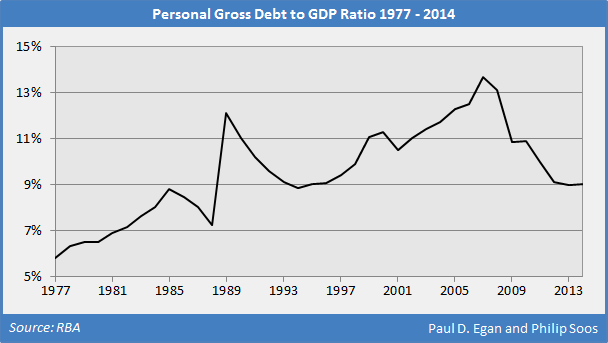
External Debt
External debts are the liabilities that Australia owes to the rest of the world, usually subdivided into the public and private sectors. A long-term net foreign liabilities series is unavailable; therefore, the cumulative current account deficits to GDP ratio is used instead as a proxy.
This ratio peaked in 1895 at 174.2 per cent, fuelled by an influx of British capital that turbocharged real estate speculation in the 1880s, culminating in a massive land market bubble. It fell away sharply, rose again during the late 1920s, and then rapidly declined thereafter. As private debt boomed in the post-WW2 era, the FIRE sector once again borrowed heavily offshore, though the rise in the ratio has been modest in comparison to earlier periods.
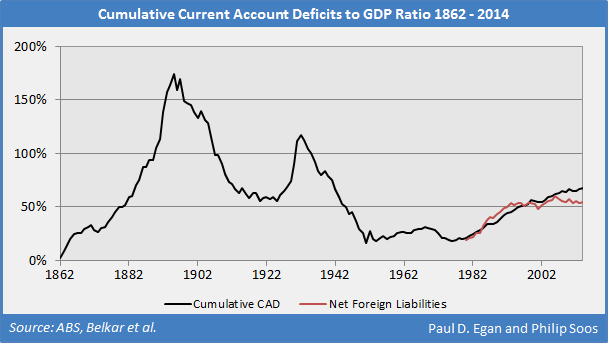
It is disconcerting that Australia had around four decades of current account deficits in the lead up to the worst depression on record in the 1890s. It is therefore alarming that Australia has run a current account deficit (CAD) since 1973 (on an annual basis) or since 1975 (on a quarterly basis). This result is due to a persistently negative net income balance, rather than a poor trade balance. The net foreign debt ratio is 54.6 per cent as of 2014. Public foreign debt is quite low, while private foreign debt is far greater.
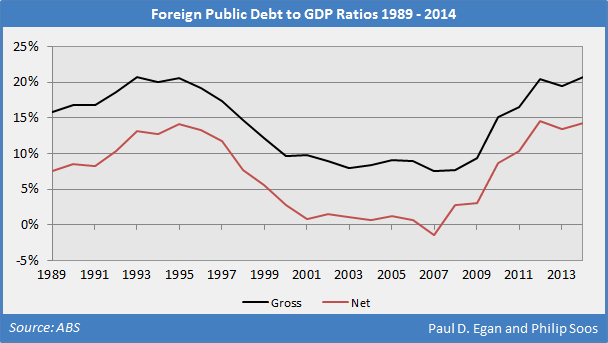
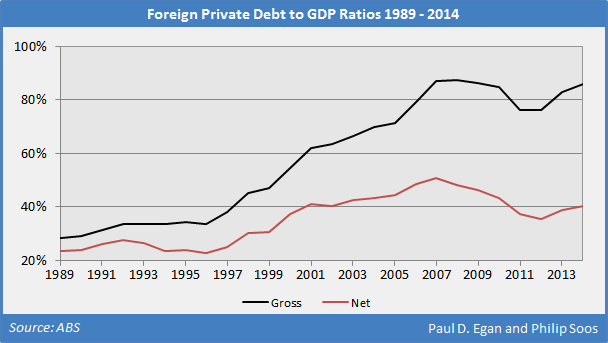
Overview
The following table outlines the different types of debt in the economy, for the latest year available. There is an important difference between consolidated and unconsolidated debts. Consolidated debt reports debt that is netted out within the sector, and only records the debts owed to other sectors, whereas unconsolidated debt is the actual debt a sector owes, irrespective of to whom. Unconsolidated debts are typically larger than consolidated debts. Caution must be taken when using measures of consolidated debt as it assumes intra-sector solvency; an assumption the GFC revealed to be precarious.
Consolidated debts disguise the risk of intra-sector debts that can metastasise and threaten financial stability. In 2013, the difference between consolidated and unconsolidated household and non-financial business sector debts was 18.9 and 24.5 percentage points respectively; a considerable difference. Unfortunately, data on unconsolidated non-banking financial sector debts are not available.
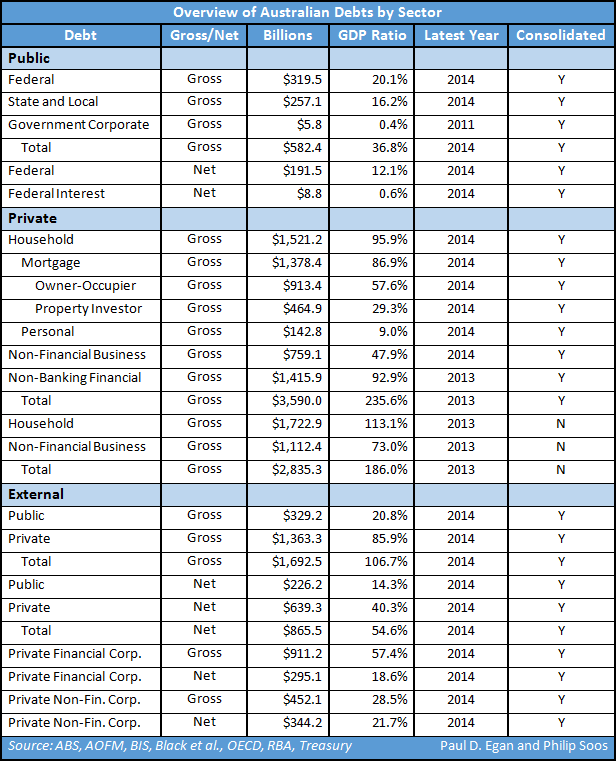
It is clear that public debt has fallen to very moderate levels, while private debts have boomed. The total consolidated household, non-financial business and non-banking financial business debt ratio peaked at an incredible 273.4 per cent of GDP in 2008. In that same year, the unconsolidated ratio would have breached the 300 per cent barrier. Data on public financial and non-financial corporations are not available after 2005 due to confidentiality concerns.
After the onset of the GFC, the non-financial business and non-banking financial sectors sharply deleveraged, but household debt continued rising. Mortgage debt reached a new peak in 2014, narrowly edging out the previous peak established in 2010, which coincides with the latest housing price booms in Sydney and Melbourne.
The following figure compares consolidated federal and state/local debt to consolidated household and non-financial business debt, where consistent long-term data are available. Clearly, the problem is not public debt, but private – and this departure is without precedent.
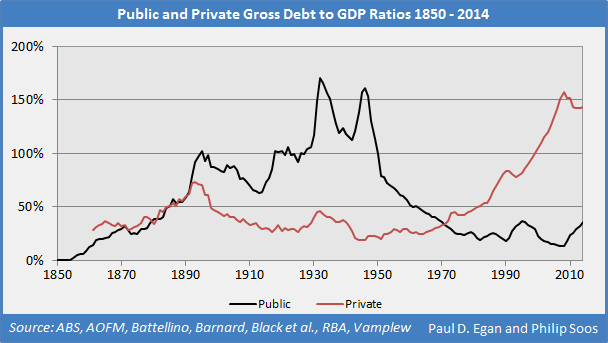
History indicates there are two major causes for increases in public debt: World Wars (1914-1918 and 1939-1945) and responses to economic recessions and depressions caused by private debt-financed speculation: the 1890s, 1930s, mid-1970s, early 1980s, early 1990s and the GFC in 2008. Therefore, the key to preventing onerous levels of public debt is to thwart the state from committing to wars, and to eliminate parasitic rentier capitalists from the private sector.
Unsurprisingly, such advice is conspicuously absent from mainstream political and economic commentary, whom ironically advocate increased expenditures for state aggression and rentier capitalism, but simultaneously maintain steadfast in explicitly opposing increasing public debt. Consequently, cuts to social welfare are advanced to further an agenda to enlarge the military and intelligence industrial complex and further subsidise the FIRE sector.
The Heterodox Perspective
There is a reason why mainstream economists ignore private debt while focusing intently upon public debt. Neoclassical economic models assume markets operate in a static state of equilibrium, but these models are based on a slew of preposterous assumptions which are never met in the real world. The banking and financial system is modelled by assuming that money, debt and banks do not exist! The element of time is also removed, making it difficult for economists to understand the inter-temporal allocations of debt.
This is like an astronomer or astrophysicist building a model of our solar system absent the sun, moon and gravity – an inadequate framework that will inevitably produce glaring mistakes. By using a circular form of logic, private domestic and external debts are assumed to be the outcome of rationally-derived contracts, so the level of debt is deemed to be efficient by definition. In contrast, public debts are considered to be managed by ‘irrational’ government planners, who cannot make optimising decisions; a clear fallacy based on stereotypes of the competency of financial actors within the economy.
In the post-1970s era, neoliberal economic policy has dominated mainstream perspectives. A major goal of government has led to an unyielding mantra that public debts must be reduced by running surpluses where possible. The obsession with public debt and deficits has blindsided policymakers to the rapid accumulation of private debts. For instance, the severe mid-1970s recession was caused largely by the collapse of the dual commercial and residential real estate bubbles, inflated by sharply accelerating private debts, but the economics profession failed to take notice.
Unfortunately, this made no difference, with the 1981 Campbell Report advocating further deregulation of the banking and financial sector. By the time of the 1997 Wallis Report, neoclassical economists had the benefit of hindsight when examining the mid-1970s dual commercial and housing bubbles, the 1981 Sydney housing bubble, the 1987 stock market bubble and crash, the late 1980s dual commercial and housing bubbles, and the lead-up to the largest stock market bubble in Australian economic history, the Dot-Com era.
With Australia’s economic history littered with asset bubbles, irrational exuberance, recessions and depressions, what were the recommendations of the Wallis Report? More financial deregulation! Mainstream economists in Australia (and elsewhere) are wilfully blind to countervailing evidence which demonstrates the harms caused by financial deregulation.
The reason that financial deregulation is advocated becomes obvious: booming private debts enhance the power, profit and authority of the horde of private monopolists, usurers, speculators, rent seekers, free riders, financial robber barons, control frauds, inheritors and indolent rich.
Another widespread economic fallacy is that government should manage debt as if it were a household or firm. This is a false analogy as the latter cannot print money and/or increase income at will. Governments that issue their own currency with a central bank do not need to operate as if they are constrained like a household or firm. Under this arrangement, a government can almost indefinitely fund deficits without fear of bankruptcy – though whether it should is another matter.
Interestingly, this analogy raises a contradiction. If government were to manage its debt like Australia’s households and businesses, then the immense private debt to GDP ratio suggests the government should embark on a mission of out-of-control spending and pork-barrelling to raise the public debt ratio considering how high the ‘rational’ private ratio is. Clearly, this is not what supporters of the analogy are advocating, even though it is a logical consequence of their logic.
More realistic and dynamic models of the banking and financial system suggest that a government dedicated to persistent surpluses will eventually cause a breakdown in the economy. The reason for this is as follows. There are three ways for income or demand to increase in a capitalist economy: a current account surplus, a budget deficit and/or increased private sector indebtedness. If government runs persistent surpluses in the face of CADs, then the only way for an economy to grow is via increased private sector indebtedness.
The dynamics of rapid and toxic private debt accumulation caused the GFC, precisely as the exponential rate of growth ended around 2008. The Howard government provides an obvious example of this trend. From 1996 to 2007, ten out of twelve annual budgets produced a surplus, while the current account remained in persistent deficit. The result: private debts ballooned, particularly in the household and non-banking financial sectors, though more slowly in the non-financial business sector.
While Howard and Costello bestowed themselves with the gratuitous titles of ‘good economic managers’, their management of debt was in fact appalling given the exponentially-growing private debt juggernaut they presided over. This runaway debt train continued under Swan and Hockey, indicating they are no better than each other regarding the issue of debt. Both sides of Australian politics have really been managing a bubble, not an economy.
A more sensible approach is for government to engage in moderate and persistent deficits of around 3 per cent of GDP. Over time, the level of public debt remains relatively constant to GDP as the economy becomes progressively larger. This helps reduce reliance on increased private sector indebtedness to grow the economy and wards off the threat that accelerating private debt could cause further asset bubbles.
Research indicates there is no evidence for a specific public debt to GDP threshold that undermines economic growth. The revelations coming out of the ‘Excelgate’ scandal have confirmed this. Unfortunately, the prevailing belief is the opposite: in an attempt to curb rising public debt and address falling tax revenues, politicians often implement austerity measures – raising taxes and slashing expenditure – which worsens any economic downturn as government and private sector demand falls in unison.
Economists advocating austerity misguidedly use equilibrium models to assert rising government debt will burden future generations and ‘crowd out’ private sector borrowing, following an alleged rise in interest rates. This view should be disregarded, as the endogenous creation of credit and the flow of causation from loans to reserves demonstrates the private sector is not limited by the scope of government borrowings (the falsified money multiplier model and commodity view of money).
If bank lending is not constrained (‘credit is created from thin air’), then it follows the standard balance sheet model asserting a dollar lent to the government is one less dollar available to the private sector is false. Further, significant lending to the public sector may ‘crowd-in’ private sector investment because the assessment of loan portfolio safety rises when it is composed of a greater proportion of government assets, typically in the form of government bonds.
If any crowding-out does occur, then it is the banks themselves that are to blame. They have chosen to lend immense sums to households instead of the more productive non-financial business sector, boosting profits from interest income and fees off a thinly-capitalised base. The result is less credit is made available to the non-financial business sector. Government is not forcing the banks to take this course of action; they have done so of their own free volition.
Reducing the Deficit
If the government was serious about reducing the deficit, it could be achieved in a far more efficient and equitable manner than is currently being pursued via cuts to social welfare and associated expenditures. Australia already has very low social welfare spending relative to GDP, relying the most upon income-testing and directing the greatest proportion of support to the poor, resulting in the most efficient outcome in terms of inequality reduction per dollar of expenditure anywhere in the OECD.
Theoretically, the deficit could be easily plugged in an efficient and equitable manner. Government should focus on reducing the scope of economic rents that are privatised, estimated at a total of $340 billion or 23.6 per cent of GDP in 2012, and slashing tax expenditures, estimated at over 8 per cent or around $110 billion in 2010, much of it directed at superannuation, mining and housing. The $8.8 billion boost to the RBA could be reversed, which didn’t ask for or require it.
$9.1 billion was lost to the repeal of the carbon tax, and another $4.9 billion from cutting the corporate tax rate to 28.5 per cent. The refusal to reform taxation onto efficient bases combined with funding of the paid parental leave policy, roads, border security, education and the latest round of foreign adventurism in the Middle East, are set to cost taxpayers tens of billions of dollars more.
As Treasurer Hockey openly admitted while in New Zealand, there is no ‘budget emergency’. The government has simply fabricated panic over the budget to ram through unpopular measures, further skewing distributional effects to advantage the wealthy. The hysteria surrounding public debt is provoked, amplified and echoed by the FIRE sector, including its economists and political allies, for several reasons:
- It distracts the public from the threat of the massive private sector debt boom. The diversion is understandable, for the FIRE sector has fuelled an immensely profitable land market bubble enriching many.
- To fabricate deceptive ‘economic Armageddon’ scenarios, advocating further privatisation of public assets and services as a ‘solution’ to reduce public debt. The end result is the expansion of rent-seeking private monopolies, duopolies and oligopolies to maximise economic rent extraction and above-normal profits.
- To prevent government from funding infrastructure and other social concerns in a more efficient manner, given its borrowing costs and fees are significantly lower than that of the private sector. The difference is economic rent, eagerly appropriated by bankers, notably via noxious public-private partnerships.
- It provides a pretext for austerity policies that deliberately disadvantage middle and lower income earners: increasing individual tax rates, reducing employees’ bargaining power and widening income disparities.
- It ensures government has room to accumulate significant debts to fund a future FIRE sector bailout. Wikileaks cables reveal that the IMF was advising the Australian government in 2009 to limit its borrowing in case it needed to bailout one or more of the Big Four banks due to their inability to rollover short-term debts.
Conclusion
The wastes and inefficiencies of government are well-known, expected and predictable. In contrast, the wastes and inefficiencies of the private sector, especially the FIRE sector, are not properly understood, are unpredictable and can quickly cascade out of control. Policymakers and economists have provided a free pass to the toxic and rapid growth of private sector debts, an outcome which overwhelmingly benefits the wealthy.
There is no intrinsic problem with public, private or external debt. All forms need to be carefully managed to ensure efficient allocations into productive, rather than wasteful and speculative, activity. As history and recent international events plainly illustrate, the most dangerous form of debt is private, followed by external, with public a distant last.
The frenzied focus on public debt is an unfortunate distraction; an increase in public debt and larger deficits would be welcome, given the weakness in the economy outside of the FIRE and mining sectors, and the social returns to public investment. Concern over historically low public debt is misplaced, despite the claims of government, the FIRE sector and many economists.
At present, the public debt burden is certainly sustainable, even if interest rates were to increase. The fashionable but unsubstantiated assertion is that rising public debt and deficits pose a risk to the economy. Compared to the pre-WW2 era, governments of today are a picture of fiscal responsibility and prudence, regardless of their political persuasion.
Australia’s history provides a test of whether a relatively high level of public debt is damaging to the economy. Coming out of WW2, the economy experienced three decades of sustained and equitable growth during the social democratic period. Australia’s experience suggests high levels of public debt are not necessarily detrimental, and the much smaller levels today are benign.
The case against public debt and deficits are based upon pseudo-scientific economic theory which has not progressed since the 19th century, political point-scoring and rank opportunism. Australia certainly does not have a ‘budget emergency’, is not ‘running out of money’, and is not headed towards ‘peak debt’ or ‘bankruptcy’. In conclusion, “Australia does have, however, a surplus of government hypocrisy and a deficit in truthfulness and competence.”